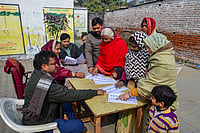Lack of urgency shown by the Centres of Excellence in treating people suffering from rare diseases like gaucher and pompe is endangering the lives of such patients in the country, NCP member Fauzia Khan has said.
Raising the issue during a zero hour discussion in the Rajya Sabha on Friday last, Khan highlighted that most of those suffering from rare diseases are children. The MP noted that the National Policy for Rare Diseases was finalised by the Ministry of Health and Family Welfare on March 30, 2021.
Many children's lives at stake
"Subsequently, the ministry increased funding support to Rs 50 lakh per patient for all categories of rare disease patients in May this year but even after several months of announcement, not a single patient diagnosed with life threatening rare genetic disorders has so far been put on life saving treatment. This unending delay and lack of urgency on the part of Centres of Excellence (COEs) has not only claimed several innocent young lives, but also endangered the survival prospects of close to 415 odd patients, largely children," she said.
Some of the patients are suffering from life-threatening conditions like gaucher, pompe, MPS I and Fabry disease. While gaucher is a metabolic disorder which leads to accumulation of fat in the spleen and liver besides other body parts, pompe is a fatal disease that disables the heart and skeletal muscles. Fabry is a life-threatening disorder that can lead to kidney and heart problems while MPS I affects the whole body and leads to organ damage.
Delay in treatment, funding
The Rajya Sabha MP from Maharashtra pointed out that close to 190 patients, out of the 415 listed for treatment, can be put on therapies with the funds provided by the Ministry of Health. "A majority of these patients have been diagnosed with rare diseases for which the Drugs Controller General of India (DCGI) approved therapies are available for many years,” she said.
She stated the 10 designated COEs are yet to seek financial support for patients diagnosed with life-threatening diseases. "This is despite several reminders from the ministry," Khan stressed. She demanded that the government should issue necessary instructions to all the CoEs for time-bound filing of applications, particularly those diagnosed with conditions for which treatment, and funding support are available.
The government in May amended the National Policy for Rare Diseases 2021 and announced Rs 50 lakh monetary aid to all groups of rare diseases. However, patients have experienced inordinate delay in procedural formalities across COEs and Ministry of Health.
In order to provide treatment and care to those suffering from rare diseases, eight COEs have been notified, which are premier government tertiary hospitals with facilities for diagnosis, prevention and treatment of rare diseases.
In October, the ministry also had written to COEs seeking an explanation for the delay in submitting treatment applications. In response, the COEs shared 19 applications with the ministry for disbursement of funds for treatment, according to the Rare Diseases India Foundation (RDIF), a patient advocacy group.
So far, not a single patient has been put on treatment by any of the 10 COEs, causing great anxiety and uncertainty to the patient community, the RDIF said.
National Policy for Rare Diseases, 2021
The policy classifies rare diseases into three groups: Disorders amenable to one-time curative treatment, those requiring long term or lifelong treatment, and diseases for which definitive treatment is available but is very costly.
The policy provides for financial support upto Rs 50 lakh for patients in Groups 1 and 2 but leaves patients in Group 3 at the mercy of crowd funding contributions. The policy called for voluntary crowd funded treatment for Group 3 category diseases, relying on individual or corporate donations.
Rare diseases are primarily those diseases that affect a very small section of population and different countries define them differently ranging from 1 in 10,000 of the population to 6 per 10,000. These illnesses can often be chronic and life-threatening and have high morbidity and mortality rates.
Since they impact very few people, curative drugs and therapies are either not available, or even when available, are prohibitively expensive.
There are approximately 6,000-8,000 classified rare diseases, but less than 5% have therapies available to treat them. According to Ministry and Health and Family Welfare data, India has close to 50-100 million people affected by rare diseases or disorders, 80% of whom are children.
(With inputs from PTI)


























